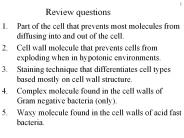Flagella PowerPoint PPT Presentations
All Time
Recommended
Usually sheathed (covered). Rotates by way of a basal body in the bacterial cell. ... Cilia and flagella share a common ultrastructure E M of the Cross-section of a ...
| PowerPoint PPT presentation | free to download
OM. Macnab R. M. Annu. Rev. Microbiol. 2003. MCP. MCP. Kinase. RR. 3. Rotation of Flagella ... What is known (as of 1973) Bacteria are motile (1676-Leewenhoek) ...
| PowerPoint PPT presentation | free to view
Uses of Cilia and Flagella. Locomotive appendages. Produce from certain cells. Cilia ... Cilia and Flagella. The difference between cilia and flagella are the ...
| PowerPoint PPT presentation | free to view
4.12 Bacterial Responses: Chemotaxis, ... secreted slime used to pull cell along a surface ... Characteristic of endospores. How long can spores survive? ...
| PowerPoint PPT presentation | free to view
Rat liver cell: nucleus, nucleolus, nuclear envelope, mitochondria, rough endoplasmic reticulum, Golgi apparatus. TEM. Section through a HeLa cell at mid-cleavage.
| PowerPoint PPT presentation | free to download
ODA complexes of sea urchin sperm flagella (A to D) and Chlamydomonas axonemes (E and F) ... have OOD linkers, but sea urchin linkers are almost parallel to ...
| PowerPoint PPT presentation | free to download
... required to collaborate, and all communication is done in a peer-to-peer fashion. ... Audio recordings can be integrated into the history. Robust document support ...
| PowerPoint PPT presentation | free to download
Bacterial Motility Hugh B. Fackrell Presentation Outline Bacterial Flagella Location Function Structure Bacterial vs eukaryotic flagella Flagellum vs Pilus Pilus ...
| PowerPoint PPT presentation | free to download
Protist, Fungi, Bacteria and Lichens bacillus Coccus Spirillium Strepto Staphlo Bacteria s Tail (Flagella) Bacteria s Tail (Flagella) Amoeba Kingdom ...
| PowerPoint PPT presentation | free to download
Gram-negative, rod-shaped, nonsporulating, motile by peritrichous flagella, facultatively anaerobic, and mesophilic, E. coli is a bacterium.
| PowerPoint PPT presentation | free to download
Gram-negative, rod-shaped, nonsporulating, motile by peritrichous flagella, facultatively anaerobic, and mesophilic, E. coli is a bacterium.
| PowerPoint PPT presentation | free to download
... Rodlike Ex: Escherichia coli Spiral Ex: Borrelia burgdorferi (causes Lyme disease) Movement Flagellum (plural = flagella) long, ...
| PowerPoint PPT presentation | free to view
Cilia and Flagella. Flagella and cilia. Consist of a 9 2 arrangement of microtubules ... Cilia. Short and numerous. Biology 11 Human Biology, TTh *;00-9:20 Dr. ...
| PowerPoint PPT presentation | free to view
Escherichia coli LPS/O antigens, OMPs, flagella, peptidoglycan, inner membrane, DNA, ribosomes, tRNA, various protein assemblies
| PowerPoint PPT presentation | free to download
... capsules and slime layers Fimbriae and pili Fimbriae and pili-2 Flagella Flagellar structures Motility revisited Axial filaments Review of eukaryotic ...
| PowerPoint PPT presentation | free to download
Cilia and Flagella. Hairlike projections from the plasma membrane. Used in ... Cilia and Flagella (cont.) Flagella when projections ... of cilia and ...
| PowerPoint PPT presentation | free to view
Car. Striated muscle. Bacterial Flagella. Limulus aroscome. Eukaryote Flagella. Mitotic spindle ... NATURE REVIEWS MOLECULAR CELL BIOLOGY 2 (9): 669-677 SEP 2001 ...
| PowerPoint PPT presentation | free to download
Cell membrane Cell wall Cytoplasm Nucleus Nucleolus Mitochondria Endoplasmic Reticulum Golgi Bodies Lysosomes Ribosomes Centrioles Cilia Flagella Chloroplast
| PowerPoint PPT presentation | free to download
Shorter than flagella. Capable of moving material along the surface of the cell. Flagella. Sperm cells carry genetic material to the egg by means of flagella. ...
| PowerPoint PPT presentation | free to view
Cilia & Flagella. Function/Description ... JOB: moves the cell by waving its cilia or flagella. Organelle Name. Microtubules ... flagella. Paramecium. Euglena ...
| PowerPoint PPT presentation | free to view
introduction to the cell flagella 15 8 prokaryotes remember no nucleus or organelles! cell wall capsule cell membrane nucleoid region with genetic material ...
| PowerPoint PPT presentation | free to view
spiral-shaped organism with internal flagella. thin, tightly coiled ... in renal tissue (post-mortem) of human patient. LEPTOSPIROSIS. Epidemiologic features ...
| PowerPoint PPT presentation | free to view
nucleoid. flagella. ribosome. Fimbriae. Cell wall. PROKARYOTIC CELL. MEMBRANE. Inclusion bodies ...
| PowerPoint PPT presentation | free to view
Flagella. Organelles of Locomotion of Mastigophorans. Flagella. Gardia lamblia trophozoite. Microstructure of Cilium. 9 2 configuration ...
| PowerPoint PPT presentation | free to view
KINGDOM PROTISTA Plant-like- Algae Animal-like- Protozoa Fungi-like- Slime Molds PHYLUM CHOROPHYTA (GREEN ALGAE) GREEN ALGAE CHLAMYDOMONAS Movement- two flagella ...
| PowerPoint PPT presentation | free to download
Structures external to the Cell Wall: ( glycocalyx, flagella, axial filaments, and pili). 1- Glycocalyx and Capsule: Many bacteria synthesize large amounts of ...
| PowerPoint PPT presentation | free to view
Outline Cell Theory Cell Size Prokaryotic Cells Eukaryotic Cells Organelles Nucleus Endomembrane System Cytoskeleton Centrioles, Cilia, and Flagella Cell Theory A ...
| PowerPoint PPT presentation | free to download
Axonemal MT specific cellular structures such as cilia, flagella and basal bodies ... important in basal body formation for flagella and cilia ...
| PowerPoint PPT presentation | free to view
Vibrio and Aeromonas Gram-negative Falcultatively anaerobic Fermentative rods Positive oxidase reaction Polar flagella
| PowerPoint PPT presentation | free to download
Tour of the Cell 1 Types of cells Why organelles? Specialized structures specialized functions cilia or flagella for locomotion Containers partition cell into ...
| PowerPoint PPT presentation | free to download
Cilia and Flagella. Cellular Respiration. Fermentation. 3. Cell Size- Why ... Cilia tend to be shorter while flagella tend to be longer. 19. Cellular Metabolism ...
| PowerPoint PPT presentation | free to view
Pond Life Protozoan animal-like single celled organisms with a nucleus. are often classified according to their locomotion pseudopods, flagella, or cilia Amoebae ...
| PowerPoint PPT presentation | free to download
Moves pseudpods in Amoeba (microfilaments) Protoplasmic streaming in ... Cilia and flagella (microtubules) Cellular motion requires. Microtubule. Motor molecule ...
| PowerPoint PPT presentation | free to view
... Autophagy Central Vacuole Mitochondria Chloroplast (a plastid) Cytoskeleton: Microtubules Organelle Movement Centrioles / Centrisomes Flagella / Cilia ...
| PowerPoint PPT presentation | free to view
Energy flows through living systems, but matter is recycled. ... Dinoflagellates - widely distributed single-celled phytoplankton; use flagella to move ...
| PowerPoint PPT presentation | free to download
Dinoflagellates Dinoflagellates Possess 2 flagella Cell wall composed of cellulose Autotrophic and heterotrophic abilities Some ability to migrate vertically in ...
| PowerPoint PPT presentation | free to view
Decomposers (saprobes), parasites, mutualistic symbionts (lichens) ... Chytridiomycota aquatic fungi; chytrids lineage closest to protists (flagella) ...
| PowerPoint PPT presentation | free to view
Gram-positive or Gram-variable bacilli Sporulating Aerobic or facultatively anaerobic Catalase positive (most) Capsulated Motile by peritrichous flagella Most bacilli are saprophytes G+C content ranges from 32 to 69%. Thermophilic (5-8°C)
| PowerPoint PPT presentation | free to view
III. Cilia and Flagella. A. Structure: '9 2' arrangement of microtubules (cellular organelles) ... Flagella and Cilia (Fig. 29-11; p. 637) IV. Muscles ...
| PowerPoint PPT presentation | free to view
Coma shaped gram negative rods with flagella ... Grows well in alkaline media. Main pathogens are cholerae , parahemolyticus, vulnificus ...
| PowerPoint PPT presentation | free to view
African sleeping sickness Chagas Alveolata Dinoflagellates distinctive flagella, protective coats, and biochemistry reproduce primarily by asexual cell division ...
| PowerPoint PPT presentation | free to view
... acidic, very saline,extremely hot with an atmosphere containing ... spirrilum and rod shaped bacteria have flagella, spherical shaped bacteria lack flagella ...
| PowerPoint PPT presentation | free to view
... do have long tails called flagella that help propel them through the water. ... That means they can make their own food. ... Archaebacteria cells undergo ...
| PowerPoint PPT presentation | free to view
Bacteria have complex envelopes and surface structures. Essential ... Some protein export machines evolved from organelle biogenesis systems (Flagella, pili) ...
| PowerPoint PPT presentation | free to view
Examples: amyloplast, chloroplast,chromoplast. PHOTOSYNTHESIS. CHLOROPLAST. Why leaves turn colors in the fall. STOMATA. What is cilia? What is flagella? ...
| PowerPoint PPT presentation | free to download
Flagella and cilia of eukaryotic cells. Organelle movement in a cell ... ALL eukaryotic cilia and flagella have the same internal structure. 9 2 arrangement ...
| PowerPoint PPT presentation | free to view
Rodolfo Hernandez-Gutierrez, Leticia Avila-Gonzalez, Jaime Ortega-Lopez, ... Facultative anerobic parasite. Adhesion proteins on surface of flagella ...
| PowerPoint PPT presentation | free to view
Plasma membrane- maintains the cell structure, but allows for ... Flagella- whip-like tail (below) Cilia- hairs (far right); most have a '9 2' microtubule ...
| PowerPoint PPT presentation | free to view
Kinetic Energy- energy of motion (mechanical energy- move flagella or the whole ... Law of Conservation of Mass- # of elements in reactants = # of elements in products ...
| PowerPoint PPT presentation | free to view
Undulipodia ('flagella'): Whiplash (2 to 1000 ) Conductive cells: Sieve cells, ... A Psilotum rhizome. Psilotophyta. A Psilotum meiosporangium. Psilotophyta ...
| PowerPoint PPT presentation | free to view
Pellicle, cilia, ectoplasm, endoplasm, food vacuole, contractile vacuole ... Cell mouth, gullet, reservoir (holds flagella), contractile vacuole, food vacuole ...
| PowerPoint PPT presentation | free to view
Eukaryotes Protista What do Eukaryotes have that Prokaryotes do not? Membrane-bound nucleus Mitochondria, chloroplasts, and endomembrane system Cytoskeleton Flagella ...
| PowerPoint PPT presentation | free to view
Gram positive. Pili (fimbriae) Cell envelope. Capsule (slime layer, glycocalyx) Cell membrane ... GRAM POSITIVE. CELL ENVELOPE. Degradative enzyme. 17. FLAGELLA ...
| PowerPoint PPT presentation | free to download
Outline Cell Theory Cell Size Prokaryotic Cells Eukaryotic Cells Organelles Nucleus Endomembrane System Cytoskeleton Centrioles, Cilia, and Flagella Cell Theory A ...
| PowerPoint PPT presentation | free to view
... the beating of flagella and cilia. Figure 7.24 Ultrastructure of a eukaryotic flagellum or cilium ... Figure 7.25 How dynein 'walking' moves cilia and flagella ...
| PowerPoint PPT presentation | free to view
Importance of ruminants to mankind has led to a great deal of ... Piromyces: zoospore with one to four flagella and thallus with filamentous branching rhizoids ...
| PowerPoint PPT presentation | free to download
























































